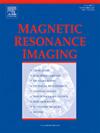利用四向相位编码的优势对EPI伪影进行鲁棒检测和校正:应用于-扩散0MRI的残留伪影。
IF 2
4区 医学
Q2 RADIOLOGY, NUCLEAR MEDICINE & MEDICAL IMAGING
引用次数: 0
摘要
目的:提出并开发一种基于图像处理的方法,用于检测和纠正回波平面成像(EPI)中残留的奈奎斯特鬼影,特别是使用弥散MRI中四个不同相位编码方向(ped)获得的非弥散加权(b=0s/mm2)图像。方法:先前的研究表明,使用四种不同的ped获取图像可以提高扩散衍生定量图的可重复性。这种改进是通过对ped进行平均来实现的,以减少残余EPI奈奎斯特幽灵工件的影响。这些残留的伪影来自于图像重建过程中应用的不完善的虚影校正,并且经常持续到预处理管道中,可能会影响下游分析。在这些观察结果的基础上,提出的方法进一步改进了这种四路编码方法,利用信号分布的特性来检测人工区域,特别是在非扩散加权(b=0s/mm2)中。虽然校正仅应用于b=0图像,但通过评估扩散衍生指标(如FA和MD)的改进,通过下游扩散张量估计来评估其有效性。此外,该方法可以考虑由于底层采集参数而导致的特定伪影表现的定位,从而对其进行定制。结果:使用已知的真实图像进行模拟,显示出很高的伪影检测精度,在没有并行成像的情况下重建的Dice得分为0.91。在体内数据集中,该方法还提高了纵向再现性,在鬼影响区域将变异性降低了30% %。结论:本文提出的校正方法在不需要任何额外的k空间数据的情况下,有效地检测和校正了残留的伪影,特别是在非扩散加权图像中。这种回顾性方法可以直接集成到现有的处理管道中,以进一步提高EPI图像的质量,并在利用4路ped采集的研究中增强图像质量。本文章由计算机程序翻译,如有差异,请以英文原文为准。
Exploiting four-way phase-encoding benefits for robust detection and correction of EPI artifacts: Application to residual ghosts in -diffusion MRI
Purpose
To propose and develop an image processing-based methodology for detecting and correcting residual Nyquist ghost artifacts in echo planar imaging (EPI), specifically using non-diffusion-weighted ( images acquired with four distinct phase-encoding directions (PEDs) in diffusion MRI.
Approach
Previous studies have demonstrated that acquiring images with four different PEDs can improve the reproducibility of diffusion derived quantitative maps. This improvement is achieved by averaging across PEDs to reduce the impact of residual EPI Nyquist ghost artifacts. These residual artifacts originate from imperfect ghost correction applied during image reconstruction and often persist into the preprocessing pipeline, potentially biasing downstream analyses. Building on these observations, the proposed method further improves this 4-way encoding approach by leveraging the properties of signal distributions to detect artifactual regions, specifically in non-diffusion weighted (). While the corrections are applied only to the images, its effectiveness is evaluated through downstream diffusion tensor estimation, by assessing the improvements in diffusion-derived metrics such as FA and MD. Additionally, the method can be tailored for specific artifact manifestations by considering their localization due to underlying acquisition parameters.
Results
Simulations with known ground-truth images demonstrated high artifact detection accuracy, achieving a Dice score of 0.91 for reconstructions without parallel imaging. In the in-vivo dataset, the method also improved longitudinal reproducibility, reducing variability by 30 % in ghost-affected regions.
Conclusion
The proposed correction method effectively detected and corrected residual ghost artifacts without the need of any additional k-space data, specifically in non-diffusion weighted images. This retrospective approach can be directly integrated into existing processing pipelines to further improve the quality of EPI images and enhancing image quality in studies that utilize 4-way PEDs acquisition.
求助全文
通过发布文献求助,成功后即可免费获取论文全文。
去求助
来源期刊

Magnetic resonance imaging
医学-核医学
CiteScore
4.70
自引率
4.00%
发文量
194
审稿时长
83 days
期刊介绍:
Magnetic Resonance Imaging (MRI) is the first international multidisciplinary journal encompassing physical, life, and clinical science investigations as they relate to the development and use of magnetic resonance imaging. MRI is dedicated to both basic research, technological innovation and applications, providing a single forum for communication among radiologists, physicists, chemists, biochemists, biologists, engineers, internists, pathologists, physiologists, computer scientists, and mathematicians.
 求助内容:
求助内容: 应助结果提醒方式:
应助结果提醒方式:


